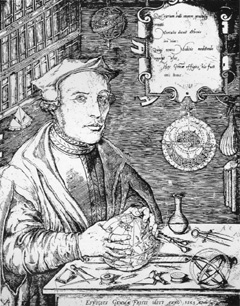
Petrus Apianus as pictured in his
Folium Populi, 1533

Johann Stalburch's engraving of Gemma Frisius in his workshop
| Home |
| Petrus Apianus (also known as Peter Apian, Peter Bennewitz, Peter Bienewitz) was born in Leisnig, Saxony in 1495. He first studied mathematics, astronomy and the other branches of cosmography at Leipzig and then Vienna. Prior to Cosmographia (1524), Apianus published two cosmographical works, a compiled world map (Typus orbis universalis) and an accompanying geographical commentary. In 1527, Apianus was appointed Professor of Mathematics at the University of Ingolstadt. Perhaps his most celebrated work, the Astronomicon Caesareum, was presented to the Emperor Charles V in 1540. This sumptuous book provided a cosmographical introduction similar to that in the Cosmographia but in a more elaborate and elegant way. Apianus' relationship with Charles V dated to least the early 1530's when Apianus was granted an imperial privilege. However, it has been suggested the young emperor may have studied cosmography under Apianus even earlier still. Following the publication of the Astronomicon Caesareum, Apianus was appointed court mathematician to Charles V, and was knighted along with his three brothers. In the following years, the success of Apianus' books and his favor with the emperor brought him a substantial degree of wealth, prestige and power. In 1544, he was granted special legal privileges, including the authority to legitimize illegitimate children and to grant higher degrees. Throughout his life, Apianus was involved in mathematical publishing, cartography and instrument making. His instrument designs included a new type of surveying quadrant and armillary spheres. Apianus died in Ingolstadt at the age of 57 in 1552. |
 Petrus Apianus as pictured in his Folium Populi, 1533 |
|
| Gemma Frisius (also Gemma Reiner, Regner or Regnier) was born in Dokkum in Friesland (hence "Frisius") in the modern-day Netherlands in 1508. Although from humble origins, Gemma studied medicine at Louvain (modern Belgium) from 1525, achieving an M.D. in 1536. In addition to his activities in instrument making and cosmography, Gemma remained a practicing physician throughout his life, serving on the medical faculty at Louvain from his graduation until his death. Although Gemma is most remembered for his contributions to instrument making and cosmography, his formal training and occupation in medicine demonstrates the fact that most mathematical cosmography was practiced outside the institutional university context. At 21 and while still a student, Gemma published his corrected edition of Apian's Cosmographia. Throughout his student years, Gemma maintained an active interest in cosmography and instrument making, publishing Gemma Phrysius de principiis astronomiae et cosmographiae in 1530 and several new and enlarged editions of Apian's Cosmographia. In the 1533 edition, Gemma first described the principal of triangulation for use in surveying, a method used even today. During these years and after, Gemma produced a great number of mathematical instruments, maps and globes. His new designs included the astronomical rings described in Cosmographia and a new kind of cross staff. During and after his schooling, Gemma ran an instrument-making workshop that achieved great renown. As late as the end of the century, Tycho Brahe commented on their quality and accuracy. Among his students were Gerard Mercator, John Dee, his nephew Arsenius and possibly the early English instrument maker Gemini. Like Apian, Gemma was patronized by the Emperor Charles V. Gemma Frisius died in 1555 at the age of 47 in Louvain. |
 Johann Stalburch's engraving of Gemma Frisius in his workshop |
|
|
||